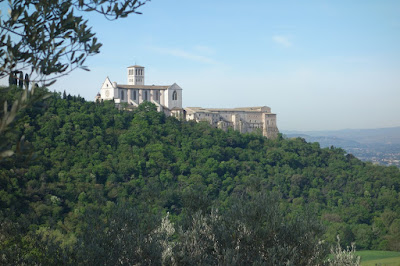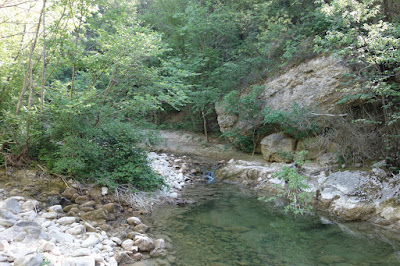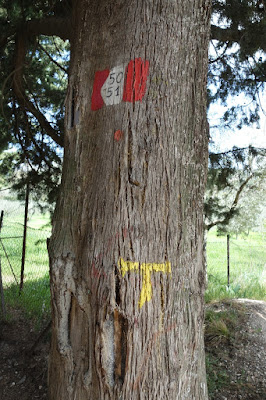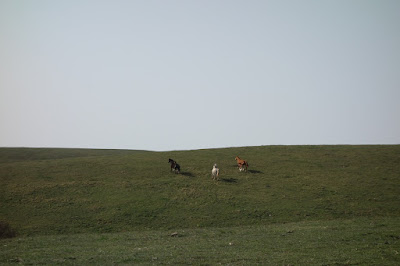Of the many trails in Subasio National Park, it would be difficult to name a favorite. All are rich in natural beauty with wonderful views. Personally, however, choosing a least favorite trail is not so difficult.
Trail #62 begins at the San Vettorino Bridge below Assisi and follows the Tescio River for about 14 kilometers to the town of Armenzano, on the side of Mount Subasio. It offers some fine views and some rugged terrain for hikers interested in something other than well-worn paths. Or even slightly worn paths.
I've now hiked segments of Trail #62 on three occasions, the first time picking up the trail near the restored Church of Santa Croce below Assisi and turning back after a couple of kilometers when the trail basically petered out in overgrown brush. The second time I followed it from Ponte Marchetto to Armenzano, again passing through rugged terrain before finally approaching the ancient fortress town, where a dog on a chain, a very long chain, ran across a dirt road to sink his teeth into my calf. But the views were nice.
Recently, having noticed a new trail sign along the road, perhaps an indicator of some trail maintenance, I again set out from above the Santa Croce Church in the direction of Armenzano, hoping to make it at least as far as Costa di Trex.
Almost immediately there was a fork in the trail. With intuition saying go left, and the red/white markings clearly indicating the the path to the right, I went right, and proceeded to climb up and up, back in the direction of Assisi. There was a nice view of the Basilica of Saint Francis.
And a fine wide view over the Tescio River valley.
However, eventually it became clear that this was not Trail #62, so it was back down the steep path to the fork, where the other path went for some ways before offering more markings. Soon I arrived at Ponte d'Annibale (Hannibal's Bridge), supposedly where the invader crossed the Tescio in 217 B.C. following the Battle of Lake Trasimeno.
It's an interesting old bridge, still walkable, although apparently it hasn't been resurfaced since about 217 B.C.
And on this day, the view from the bridge of the Tescio River was…. well, let's just say the Tescio wasn't exactly overflowing its banks.
There hasn't been much rain of late. Actually, the Tescio can turn into quite a torrent under heavy rain conditions, with its flow eventually meeting up with the Chiascio River, which leads to the Tevere (Tiber) River, which, of course, flows through Rome. The depth (or lack thereof) of the Tescio on this day would come into play a little further along.
As with my first attempt at Trail #62, the path soon began to fade into the surrounding vegetation.
Still, in most places it was not too difficult to follow, or at least to guess where the next trail marker might be, though there was a significant amount of thorny brush needing to be pushed back to avoid tears. What was interesting was that the trail began to traverse back and forth over the river bed. Not a problem, as long as the bed is dry. Eventually I came to what was once a mill on the river, now a residence. Laundry day.
In such rural settings hikers may anticipate hearing from the family dog. Or in this case, the family dogs, which took to barking loudly but, thankfully, did not present themselves. Not sure how many were announcing my arrival/departure, but a nearby scene provided a hint.
A little ways along some puddles appeared in the Tescio, followed by a small trickle, followed by a modest flow. The pleasant surprise of having water in the river was quickly tempered by a realization that the riverbed trail crossings were likely to continue ahead. Sure enough, they did.
At first, they just involved some rock hopping, a bit of caution to avoid wet feet. Besides, when not in the river, the trail had turned back into a good path.
A good path that eventually was blocked off with barbed wire intended to prevent people from entering the area I had just walked. I carefully worked around this obstacle and turned back to read the sign posted on it.
Which mean,
Attention! Animals in the pasture. Closed. Thank you. Which is fine, although I hadn't noticed any animals in the pasture or, for that matter any pasture worth grazing, since shortly after leaving Assisi. Even if there were animals in a pasture, not sure why the trail would need to be closed, unless the animals were of a sort that don't appreciate visitors….
The Tescio was growing prettier and deeper.
Unfortunately, the trail soon took another turn for the worse, with increasing slopes, thorny brush and more rough terrain. I passed a spot where there was a small side trail that looked like it might lead up and out of the river basin. After going a bit farther, seeing the river continue to widen, and able to guess from the surrounding hills that Costa di Trex was nearby, I decided to backtrack and try the side trail.
First, a bit of uphill slope, followed by a gradual climb.
Then finally up out of the brush to some local views near Costa di Trex, and a road leading back to Assisi
So, Trail #62 is a bit of an adventure. Perhaps one day I'll revisit it again, or at least sections I've not yet walked. The Marchetto Ravine, also reachable by another trail, is well worth seeing. However, hikers beware, Trail #62 poses some challenges and dangers, not the least of which would be rising waters during rainy times. And there are plenty of other fine walking options throughout Subasio Park.
Ciao.
































































